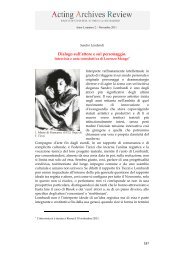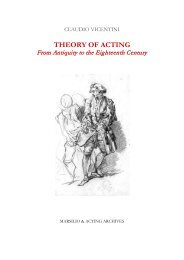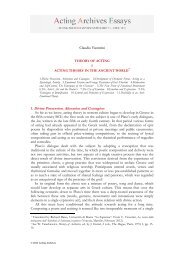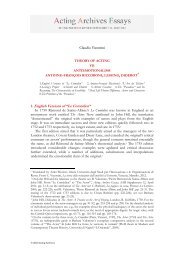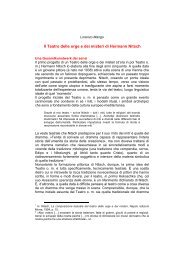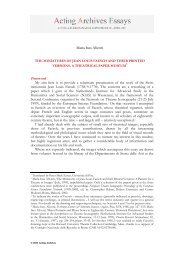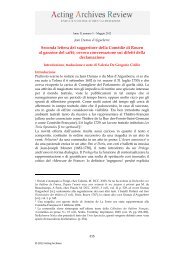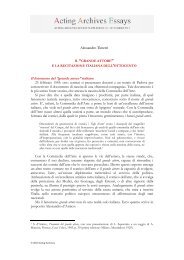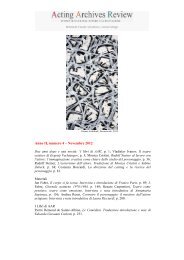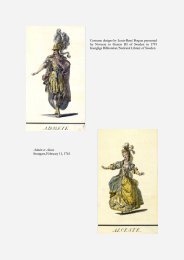Flavia Pappacena_Noverre's Lettres sur la Danse - Acting Archives
Flavia Pappacena_Noverre's Lettres sur la Danse - Acting Archives
Flavia Pappacena_Noverre's Lettres sur la Danse - Acting Archives
You also want an ePaper? Increase the reach of your titles
YUMPU automatically turns print PDFs into web optimized ePapers that Google loves.
AAR <strong>Acting</strong> <strong>Archives</strong> Essays Supplement 9 – April 2011<br />
with the most wide-ranging characters while suppressing his own personality (‘The<br />
change once effected, the actor disappeared and the hero was revealed’). 33<br />
Mr Garrick, the celebrated English actor, is the model I wish to put forward. Not only<br />
is he the most handsome, the most perfect and the most worthy of admiration of all<br />
actors, he may be regarded as the Proteus of our own time. […] He was so natural, his<br />
expression was so lifelike, his gestures, features and g<strong>la</strong>nces were so eloquent and so<br />
convincing, that he made the action clear even to those who did not understand a word<br />
of English. It was easy to follow his meaning; his pathos was touching; in tragedy he<br />
terrified with the successive movements with which he represented the most violent<br />
passions. And, if I may so express myself, he <strong>la</strong>cerated the spectator’s feelings, tore his<br />
heart, pierced his soul, and made him shed tears of blood. 34<br />
The various iconographic sources avai<strong>la</strong>ble make much of the expressivity of<br />
Garrick’s body, arms and hands, but Noverre chooses to focus on the expressive<br />
force of his face and eyes. The insistence on this specific aspect is not simply another<br />
stroke in his campaign against the masks worn by dancers in the academic ballets.<br />
Facial expression was an essential counterpart to verbal expression in Garrick’s<br />
performances, but as can be seen in the famous portrait of him as Richard III<br />
painted by Hogarth in 1745, the eyes and hands p<strong>la</strong>yed a crucial role. In 1803<br />
Noverre recalled the importance which Garrick himself attributed to the arms, hands<br />
and even the fingers (‘tongues which can speak’ as he described them, adopting an<br />
expression of Garrick’s). But if in 1760 Noverre extolled the expressive function of<br />
the face, the ‘faithful interpreter’ of mime, 35 in 1803 he insisted on the crucial role of<br />
the eyes:<br />
this variety and mobility would be imperfect if the eyes did not add the mark of truth<br />
and likeness; I can compare them to two torches, designed to light up the features and<br />
bathe them in that light and shade which will give them distinction and significance.<br />
Without the eyes there can be no expression, no truth, no effect. 36<br />
If we merely go on what Noverre had to say about gesture in the <strong>Lettres</strong>, we risk<br />
forming only a partial picture of his conception of the art of mime. Other<br />
iconographic and literary sources make clear – whether directly or indirectly – to<br />
what an extent the torso of the protagonists in Noverre’s ballets was involved in the<br />
movement of the whole body, albeit within the limits imposed by the social status of<br />
the character, the event and the need to respect the aesthetic canons of c<strong>la</strong>ssical art.<br />
We can refer to the figures illustrated by Louis-René Boquet, who col<strong>la</strong>borated<br />
closely with Noverre over such a long period that he must <strong>sur</strong>ely have assimi<strong>la</strong>ted the<br />
33 1760, Letter IX, p. 213; Beaumont, p. 83.<br />
34 Ibid., pp. 209-210; Beaumont, p. 82. There is also a detailed description of Garrick in the letter<br />
Noverre wrote to Voltaire in 1763 published in tome II of the 1803 edition (Letters XVIII and XIX).<br />
35 ‘The face is the vehicle of the mimic scene, the faithful interpreter of all the movements in<br />
pantomime’. Ibid., pp. 196-197; Beaumont, p. 78.<br />
36 ‘cette variété et cette mobilité seroit imparfaite, si les yeux n’y ajoutoient pas le signe de <strong>la</strong> vérité, et<br />
de <strong>la</strong> ressemb<strong>la</strong>nce; je les comparerais à deux f<strong>la</strong>mbeaux faits pour éc<strong>la</strong>irer tous le traits, et y répandre<br />
ce c<strong>la</strong>ir-obscur qui les distingue, et les fait valoir. Sans les yeux point d’expression, point de vérité,<br />
point d’effet’. 1803, t. II, Letter VIII, p. 84. On the importance attributed to the face and the<br />
inappropriacy of masks, Noverre agreed with Cahusac: see the article ‘Geste’, published in 1757 (in<br />
Encyclopédie, VII, p. 651).<br />
10



